chapter 8
He [Adrian Paul] was quite the birder. He even argued with Roger Tory Peterson about the marks on some bird’s head. Some sparrow I think.
—Ken Jansen
Her father, Mr. Paul, I really enjoyed him. He was quiet. He had this dresser set full of little drawers and inside were all these birds’ eggs he had collected. He would show them to me and talk about them.
—Rhonda Nygaard
There’s a funny story about Mr. Paul. Well it’s not really funny, but you have to laugh.
W— B— had a bad asthma attack at the bridge by your turnoff, and Mr. Paul found him. Mr. Paul was—what do you call them?—an ornithologist. He spotted all kinds of rare birds. Anyway, one day we get this phone call and it’s Mr. Paul. He’s all excited about this bird he’s seen—I dunno, a yellow-bellied fluffy-headed something. He’s telling us all about it. How it sang and how close it was to him. Then he says: “Oh by the way, could you please phone the RCMP and tell them there’s a dead man at the bridge and you should have seen the way this bird flew this way and that . . .” Well we laughed for a long time over that. He must have been about eighty-eight at the time.
—Louise Moxon
Spring. Nedra Creek roared over the snow from the upper property, its waters flashing and sparkling blue in the sunlight, and plunged into a widening hole in the river. Chunks of ice began to collapse in the river itself and the water began to rise. Suddenly there were silvery buttons on the early species of willows—I swear they had not been there the day before. Cottonwood buds started to swell and form the sticky outer coat that smells so divine after a spring rain. I brought twigs of both species into the cabin and sat them in canning jars on a sunny windowsill beside trays of sunflower and quinoa sprouts.
The first spring migrants came through; as in the mountains, the herald was a junco. I scrounged up a bit of board, rimmed it with offcuts of one-by-threes, and nailed it to a post stuck into the snow just outside the bay window. Now I had a bird feeder; within days, upward of thirty juncos were scrapping and posturing. I loved the way that two would face off and, with little twittering noises, would try to stand taller than their opponent. Redwing blackbirds were next, flashing their wonderful red shoulder patches, then other species of blackbirds, song sparrows and pine siskins. As soon as the south-facing slopes lost their snow, robins sang. Varied thrushes, red-tailed hawks, purple finches, gold-crowned and white-crowned sparrows, song sparrows—the list was exciting, with new birds arriving every day. Many of these species I had never seen before, as the ecology here was quite different from that in the mountains. Red-naped sapsuckers. Red-headed woodpecker. Evening grosbeak. Woodpeckers beat tattoos on dead branches, flickers cackled, ruffed grouse drummed on fallen logs, snipe made their ghostly winnowing over the ponds in the upper property. Northern harriers swooped the open spaces. Rough-winged swallows, yellow-rumped warblers. Once, flying overhead with pterodactyl silhouette and a croak fresh from the swamps of Siluria, a sandhill crane. Dick Cannings has stated that the Chilcotin is the bird world’s best-kept secret, and here I had my own private wetland—as well as a patch of open grassland, and the river, and the bluffs, and the forest. All these eco-niches encouraged different species. How glad I was that I had not taken any of the other properties I had looked at, as none of them had anything like the diversity of this landscape. Many species I could not identify. Their observation was going to provide me with years of joy.
The wildflowers, on the whole, were disappointing. Mostly introduced species, they were sparse on the ground—nothing like the fabulous alpine abundance I had come to accept as my backyard in the mountains. A few early purple violets peeped shyly along a bank, and dandelions made forests of yellow suns where the ground had more recently been disturbed. The terraces of Ginty’s garden were still evident below the Packrat Palace, and in the rhubarb patch, convoluted brain clusters of new leaves started to push through the blackened sprawl of last season’s plants. There were several comfrey plants, too, but I couldn’t see much else that had survived until I crossed the roaring creek on a weathered, wobbly plank and found a lawn-sized plot of chives. Dandelion leaf and chive salad was on the menu for quite a while.
The road took a long time to dry up. The end closest to the cabin received more sun and it rotted out first; just when this was more or less usable again, the part closest to the highway disintegrated. If I wanted to go to the post office and store I would leave early in the morning when the road was still frozen, but the post office was open from eleven ’til two and the mail truck came around noon so the road was generally pretty bad when I returned. Other occasional visitors to both myself and Edgar’s property were not so mindful of the damage being done and they churned back and forth in the afternoons, leaving a legacy of ruts and bogholes. The road would no longer be the dusty and little-used bush trail that I had travelled over the first time I saw Ginty Creek.
The road was still in pretty bad shape when the first wwoofers arrived in mid-April. Claire and Ron lived in Nanaimo and they had driven up in their town car. They were so appalled at the state of the road they parked near the end and walked the four kilometres to the cabin. I assured them we would be able to retrieve the vehicle in the morning. They were to sleep in the little trailer; I hoped it would be warm enough for them. There was no means of heating it. The sun blasted on it during the day so it was not too bad in the evening but it was still freezing hard at night and the mornings were frigid.
Claire and Ron were a little different from most wwoofers in that they were my age. They had no less energy than the younger ones, however. Ron was a handy carpenter, which was a great bonus, and Claire was a cleanup whirlwind. I had inherited a large area of decayed wood and other garbage around the cabin that had never been moved in the fall—there had been no time then—and this was now emerging from the snow. It became apparent that there had once been three outhouses among the debris; they must have serviced the cabin on the knoll that Ken had stayed in. But why three?
Before Ron and Claire came, I had been chipping away at the ice around the door area where the porch was going to be. I would chop a bit, then wait for it to thaw, then chop again. Eventually the foundations appeared. The previous fall, I had propped scrounged logs and poles and heavy boards against a nearby fence so that they could easily be found in the spring. Now I could use them to frame the porch walls and put rafters across for a ceiling. When Ron and Claire came, we nailed on the boards for an upper floor, stripped off the old green tarp and set up rafters and strapping. The remaining pieces of roofing had been stored in the attic; these were now retrieved and we managed to put all but the last two on before my helpers left. When it was too windy to work on the porch, we built a bigger woodshed, and cut and hauled more wood. One day we trudged through the crisp, patchy snow to the upper property and I started to fall trees where my house would eventually be.
Claire and Ron were fun. Claire had been brought up in francophone Manitoba and she had a strong French Canadian accent. She had problems pronouncing the “th” sound. We played Scrabble and one day she used a three-lettered word that I did not recognize. “It’s in t’e Scrabble dictionary,” she said. “It’s a tree-tooted slot.” I did not want to be impolite but I could not help myself and burst out laughing. She was trying to say a three-toothed sloth!
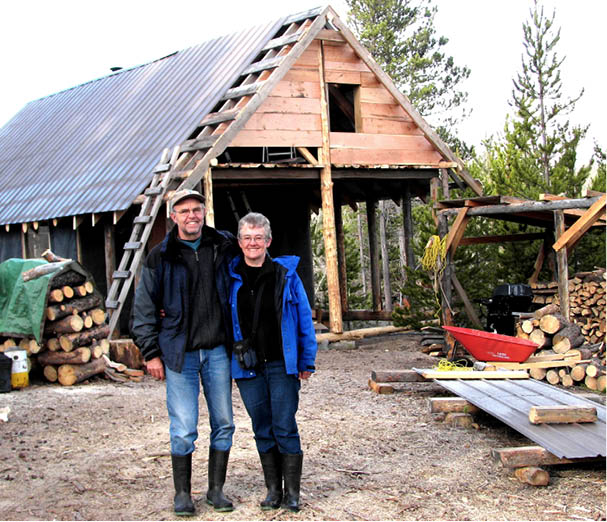
Ron and Claire.
Now it was May. Bits of snow kept falling. I had set up a hand pump to make it easier to get water from the river, but half the time the pipe was frozen. I started making a road to the new building site. I had marked it with flagging tape while the snow was still thick on the ground. It angled off the bush trail that had once serviced the sawmill. There was a wet area partway along that would need a culvert before a vehicle could be taken over it. I did not mind cutting the scrubby, sometimes dead, pines so much, but it was sad to bring down the aspens. They were so beautiful in the fall and now they were beginning to sport a mist of green. I also worked on the access to the building site from the lower end. It was far too wet to put a road in from that direction but I made a wheelbarrow trail so I could carry tools up that way. I built a stile to cross the snake fence that Ken had put up for his cows.
In the middle of the month I went to Williams Lake to pick up a huge pile of supplies, much of it for the mountain business, and three more wwoofers. Boris and Sven were both from Belgium, although they had not met before they arrived at the bus station in Williams Lake. Sven was in his early twenties, Boris only nineteen. Monika was from Switzerland and was a little older. She would be arriving at the airport in the early evening. I jammed them and all their gear into the van somehow—a lot of stuff was tied onto the roof. Monika would have the trailer and the boys would have to sleep in tents.
Wwoofers are supposed to work half days. I tell them that as long as they work half the time, that is fine. They can slave for a week and take a week off—they will still get fed. The deal with these three was that they would work hard for me at Ginty Creek (with a few breaks) and then come into the mountains for a two-week vacation. It was not to work out quite that way.
They were incredible workers. We filled the woodshed ready for next winter and finished the porch roof, and the boys built a barrier in the attic to make two rooms, fitting windows scrounged from the Packrat Palace in either end. I continued to fall trees to complete the road to the upper place, then they cleared everything off the right-of-way, peeling any log that was remotely straight (Monika was an incredible peeler) and piling the rest for future firewood. I cut down a lot more trees on the site, and now I had a view of the mountains. I also had an enormous mess of brush and stumps and logs. It was brutal work, but the weather warmed and soon it felt like summer. We had one gloriously hot bug-free day. On the next, they hatched.
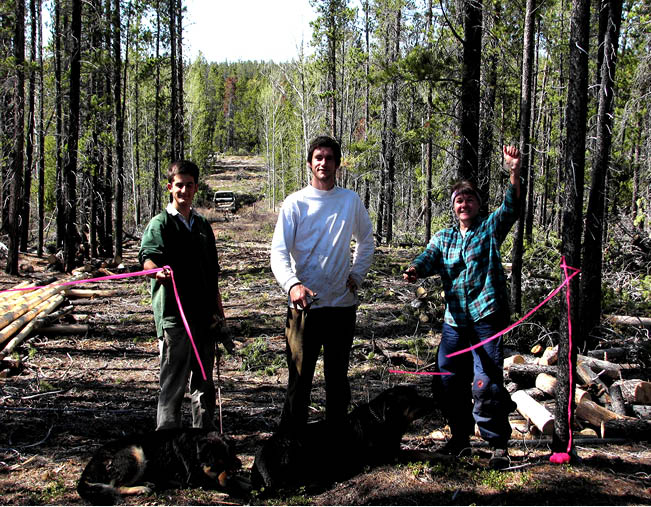
From left: Boris, Sven and Monika opening the new road.
We went down the famous cliff-hanging switchbacks known as The Hill to Bella Coola. Friends own a property at Stuie at the upper end of the valley. They were not home but were happy for us to stay overnight. The house used to be my outside base when I lived in the bush near Lonesome Lake, and I spent a winter there once. The scenery is spectacular. The coastal forest in spring is weeks ahead of the Chilcotin and I always love to visit, especially at this time of year. The winter gloom and rain is something else, however. I would not be able to live there full time.
We went to see the bears. In fall, they are to be found along the river, eating the spawning salmon. In spring, they camp out on the roadside. Down in the valley we spotted a number of black bears, singly and in groups, wallowing in the lush green grass and dandelions, but our best sighting was back up on the Chilcotin not far from the top of The Hill. Way ahead of us, a car coming the other way had stopped. Nearby was a dark mound that appeared to be moving. I slowed down so as not to scare the animal away and ruin the other car occupants’ chances for photos. I needn’t have worried. The other car left and we parked right beside a magnificent young grizzly male with a pale stripe across his shoulders who could not have cared less about us. I warned the wwoofers to stay in the vehicle both for safety reasons and also not to crowd the bear unnecessarily. Stay in the vehicle they did—just. Everyone was hanging out of every door and window as far as they could to take pictures. The bear eyed us once or twice but ate calmly. We were so close that when I zoomed my camera all I got in the frame was part of his head.
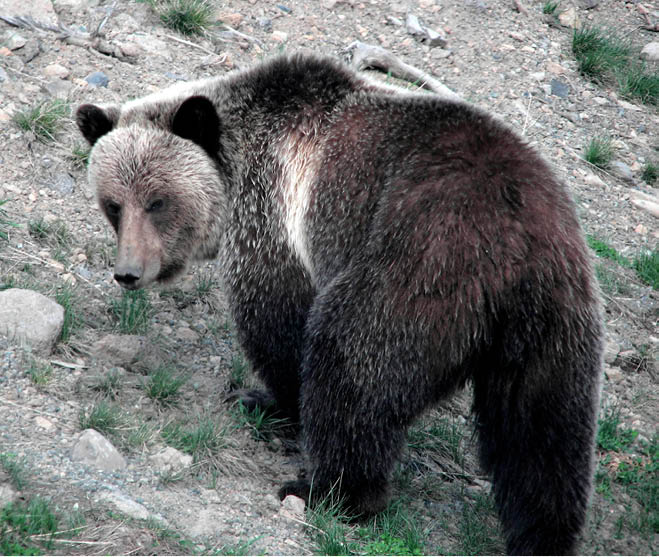
The young grizzly boar beside the road.
At the end of May all the local ranchers turn their cows out onto the open range. At first the animals crowd the roadside, as that is where the grazing is. Driving becomes a nightmare because the calves have not yet learned to keep out of the way. Sometimes they are on one side of the highway and their mother is on the other, and at the last minute they panic and run across. One ranch makes a two-day cattle drive from Kleena Kleene to Anahim Lake. The highway becomes paved with a mess of sloppy fresh cowpoop.
The rancher at the Precipice, where Dave and Rosemary live, drives his cows up the side of the valley to an area beyond the basalt rim. He makes a party of it; half the countryside attends and there is a barbecue and lots of homemade music. I see people I haven’t seen since the last cattle drive party a year before. I would class most of them as neighbours even if they do live sixty kilometres or more away.
I arranged to take the wwoofers down to the Precipice with me. Because of the excessive snowfall the road was barely thawed. About halfway down, the rancher had bogged his truck and we had to park above it; Dave met us and ferried us into the valley with his Suburban. The river down there had broken its banks in a couple of places and washed away the farm roads. There was water everywhere. We stayed an extra day or two, and while I visited with Rosemary we put the wwoofers to work helping to prepare Rosemary’s extensive vegetable garden.
It had been excessively hot for over ten days before that weekend. Temperatures had reached 28°C. Everyone was worried about flooding due to the exceptionally heavy snowfall. Then, while we were in the Precipice, it poured with rain. We returned to Ginty Creek to find that my river, previously several separate skeins flowing around a number of gravel islands, was now wall-to-wall water. Brown and roaring, it was lapping the tops of the banks.
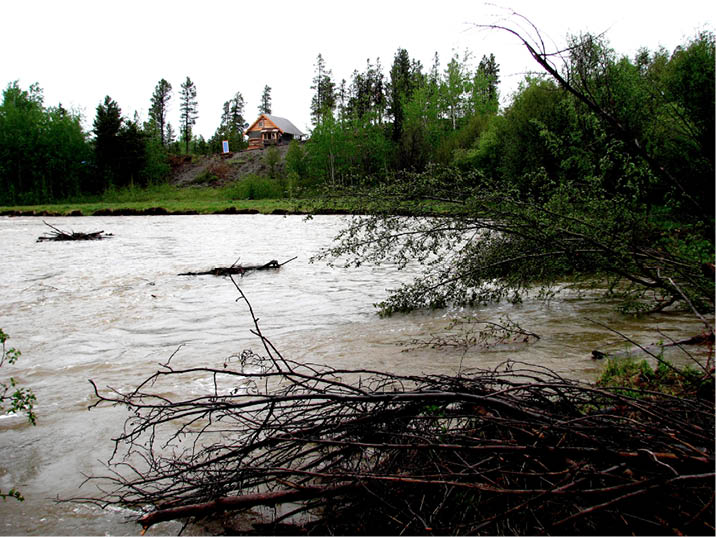
The spring flood.
More chunks of land had fallen into the river, including a large piece very close to the trailer. A corner of the snake fence now hung over the water unsupported. A group of mature cottonwoods on a point that jutted into the river had been a prominent part of the view from the bay window of the cabin. Three of these trees now lay in the water, their newly leafed-out branches half drowned in the boiling flow and their roots catching all manner of floating debris. That evening, in the half-light, a cow moose walked into the river just past the new logjam. I was sure she would be swept away, but no, she calmly waded from one side to the other, the water piling up against her flanks. Moose are such disjointed-looking beasts, but so supremely adapted to their environment.
During my twenty years in the mountains, the ice has gone out from the lake at Nuk Tessli between May 17 and June 4. I like to get in there as soon as the lake is open: it is so wonderful to watch the land explode from the grip of winter. Because of the heavy snow, I expected breakup to be later rather than sooner this year. A pilot had flown over on June 3 and reported a lot of open spaces in the ice; the owner of the float plane base figured we would probably be able to go in on the 6th. As we drove to the float plane base there was not a single square centimetre of the van that was not occupied. The two boys, one of whom was very tall, were crammed into less than a single seat space in the back (they shared a seat belt and I hoped we would not meet any cops); Monika had several items piled between her legs and on her lap. I sent the wwoofers off in a smaller plane so they could have a flight-seeing tour as a thank you for all the work they had done. Fortunately it took a long time for me to load the Beaver with the dogs and freight, and I also had to wait for a pilot to return from another job. We were just taxiing out when the smaller plane returned. The wwoofers were still inside it. They had not been able to land because the lake at Nuk Tessli was still frozen. This was obviously going to be a record year for the ice, and it would in fact be another week before we could fly in.
Which meant we had to return to Ginty Creek.
We left some of the freight in the hangar at the float plane base so that we could drive back in greater comfort and safety. The river had peaked and was already dropping. I had been observing unfamiliar mounds under the roiling brown water; now these emerged as new piles of flood debris, either lumps of bank or piles of logs, some of these newly swept away from where they had grown and still bearing leafed-out branches. As I watched the brown swirls and riffles, it seemed as though the main channel might have changed, and sure enough, as the water dropped, a whole new landscape was revealed. Instead of curling around the closer bank, the main stream now rushed by on the far side of the river.
One day I went to the river to rinse clothes and heard a strange cry. I thought it might be a bird I did not know and crept cautiously through the thick alders along the bank. On the far side of the river, on an emerging patch of gravel, was a newborn moose. The cord was still hanging from its belly. I ran back to fetch the wwoofers, but warned them to be very careful as cow moose can be very dangerous when they have young calves. Of the mother, however, there was no sign. At first, when the calf saw us, it tried to cross the river. It waded in, was nearly swept away, and scrambled out again. I had come across this kind of thing once before when two mule-deer fawns had temporarily lost their mother. They had run to my side; presumably they are programmed to attach themselves to something tall. When the mother called them they were gone.
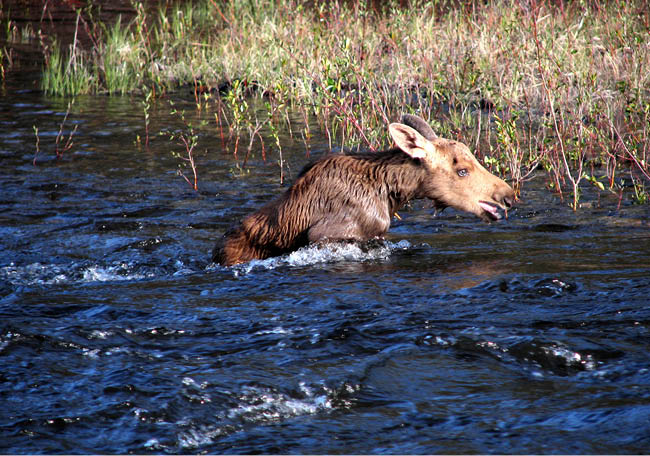
The baby moose.
The moose calf’s little cry was a bit like the baaa of a sheep, but without the quaver. “We’ve got to do something,” said the wwoofers, but the baby was on the far side of the water and we certainly could not cross. I went back to the cabin and emailed anyone who might be interested in trying to rear it: we could not take it on as we expected to be going into the mountains in a couple of days. I phoned the wildlife service but got an answering machine (there is only one warden for half the Chilcotin.) The wwoofers ran back up from the river. They were wildly excited because the calf had actually swum across and one of the boys had touched it, but it had gone back into the water before he could catch it. It had been swept quite a way downstream before it had been able to scramble out.
The day drew on and the sun went down. Monika’s trailer was right opposite where the calf was still bawling, bawling. I was in bed and it was dark when the wwoofers came up. “We’ve got to do something,” they begged again. “I suppose we could drive around to the ranch and see if we can get to it on that side of the river,” I said. “What are you going to catch it with?” It appeared that they thought it would simply lead like a dog. I had dealt with enough cattle in my life to know that, newborn or not, the baby moose would probably kick like a mule. I phoned the ranch. They had irrigation pipes over the field so we would have to walk from their driveway. We found a flashlight, a sack (to put over the animal’s head to try and calm it) and some rope. Sven grabbed a quarter-full jug of milk. “How are you going to give it that?” I asked. “It will want to suck. You won’t be able to pour it down its throat.” “I’ve got a condom,” said Sven. “Would that work?” There, I thought, is a wwoofer who is prepared for everything.
We drove round to the ranch, walked across the field and climbed the fence. We would have to fight our way through a swampy thicket of cottonwoods and alders. We thrashed to the gravel bar where we had seen the calf. Except for the gurgle and chatter of the river, there was silence. We hunted up and down for a half-hour or so. Not a sound. That moose calf had been bawling for nine hours. What had happened to make it stop during the thirty minutes it had taken us to drive around to the ranch and walk across the field? Did it fall into the river and drown? Did something eat it? Did its mother come back for it? We returned to our side of the river and to silence. It was a mystery we would never be able to solve.